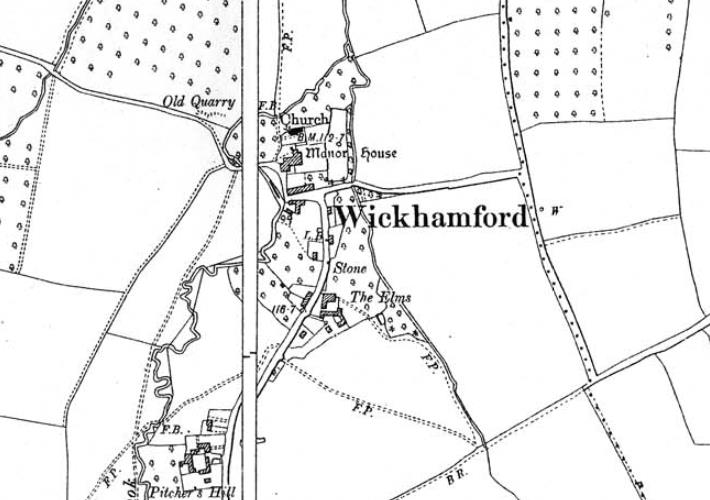The 1903 6” Ordnance Survey map of the area of Wickhamford by the Church and Manor has marked on it ‘Old Quarry’. It is situated at the point where two houses, 1 and 2 Manor Cottages, on Wickhamford Lane, now stand. These were built in about 1906.

William Mason, born in 1899, had his early memories of Wickhamford recorded by Reverend Peter Braby. He referred to a stone quarry belonging to the Mason family. The large field on the opposite side of Wickhamford Lane was called ‘Quarry Ground’ at the time of the September 1930 auction of the Wickhamford Estate (Lot 18). Some of the auction particulars of the area where the quarry was shown on the 1903 map are as follows, in Lot 17 :
“Rook Tree Ground, 2 acres, 1 rood 27 perches, situate adjoining Wickhamford Lane, let to Mr J. W. Mason at £6 1s 0d per annum; also the Estate Quarry situate adjoining and in hand”
The auction particulars of the earlier sale of the Wickhamford Estate by the 4th Baron Sandys in 1869 has mostly different field names, but significantly makes no mention of any quarries.
Geological background
All the bedrock in this area is Lower Lias, about 205 million years old, from early in the Jurassic period. This area was under a shallow sea at this time. The bedrock varies a lot, so gives rise to different types of quarrying. The edge of the formation runs NE to SW down the Midlands and on to Dorset and locally there is a ridge which runs roughly in this direction. Where there is higher ground on this ridge the Lias is very hard and lies in flat beds as a flagstone. This was quarried specifically for flooring and roof tiles. It was also used for building stone with oolitic limestone from the Cotswolds forming the quoins or corner stones and window surrounds, as this was much easier to carve.
The poorer quality stone was quarried for lime burning and there were regular quarries along the outcrop producing agricultural lime to send north for improving soil quality on the Triassic sandstone soils.
Quarry stone usage
The most common type of quarry in this area was for lime kilns, but it was very unlikely for there to have been have such a smokey structure so close to the Manor. It was probably most likely to have been for building stone, to be used very close by. The cost of stone transportation was very high in the 19th century, because of the weight, and with only horse-drawn carts available. The quarry was probably not very deep because, being near to Badsey Brook, it would have filled up with water.
It is guesswork to suggest what the stone from the Wickhamford quarry was used for, but one possibility is that it was used to surface Wickhamford Lane. At that time, it was a short practical route to Bengeworth and Evesham. If some stones found were of a reasonable size they may have been used for the construction, or repair, of boundary walls at the Manor.
Conclusions
The quarry by Wickhamford Lane was possibly in use for only around 30 years. It was not mentioned in 1869 and marked as disused by 1903. Any stone would probably have been used very locally for repairs to roads or some wall maintenance. There are no records in the censuses for Wickhamford, 1841-1911, of any men employed in quarrying nor is the job referred to in the parish registers. Any work undertaken would have been by general labourers doing a range of other jobs on the farms in the village.
Acknowledgement: Thanks are due to Ian Gibson for his input on the geology of the area.
Tom Locke - July 2020
